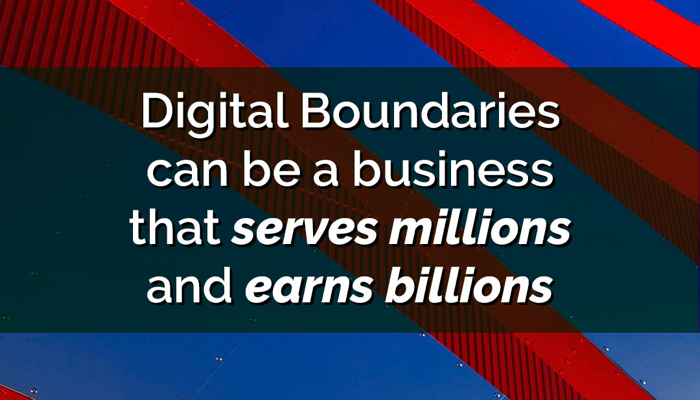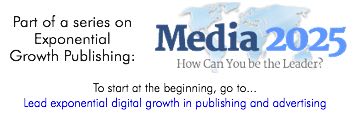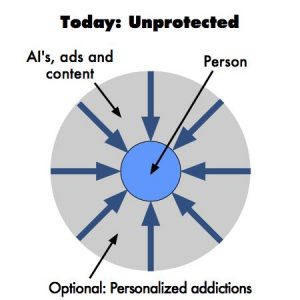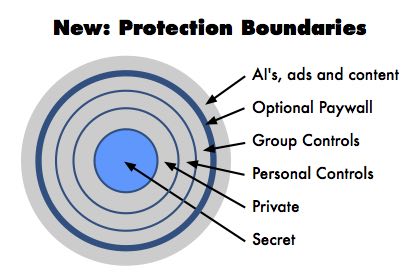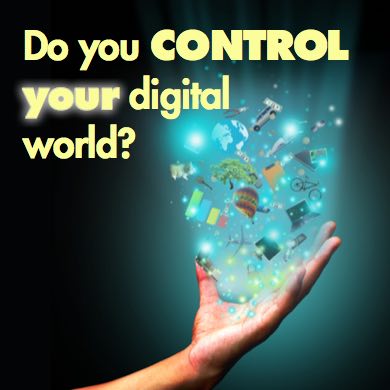Lesson for leaders
If you had told Google and Facebook when they went public in 2004 and 2012 that they would capture one-fifth of global advertising revenues in 2016 they would have thought you were crazy.
As these companies proved, new and disruptive technology platforms can capture huge revenues in the ad industry. With the right technology and strategic thinking, the ad business is ripe for competition and disruption.
Digital Boundaries are a shift to people-first technology that gives the user control over the user interface. Today an individual manually changes a device’s whole screen to the topic they want. But the user’s instructions can be automated, just like many other steps. Then the interface displays what the user wants to see and an illustration is ad-blocking.
When users control the interface they can change the commercial choices on their screens. Food products can show healthy eating. Energy products can slow climate change by replacing fossil fuels with renewables. Advertisers and vendors will access consumers on each user’s terms, giving people new power to guide a people-first economy.
These digital boundaries lead directly into connected consumption to buy and use digitally enabled products and services. Consumers will work with people-first companies who will build and deliver the world in which people choose to live.
This switches capitalism from Adam Smith’s “invisible hand of the marketplace” to “people-first visible markets” that consumers will guide through their digital boundaries.
Decline today, dystopia tomorrow?
We constantly use technology to protect ourselves from other technologies. Parts of the internet are like a broken sewage system that pumps raw filth at us, forcing us to control it or be unsafe and insecure:
- Spam-blockers: spam emails dwarf real email
- Antivirus and firewalls: viruses, spyware, Trojan horses, and some tracking cookies make “going online” risky
- Ad-blockers: intrusive ads fill screens, hog bandwidth, auto-play unwanted videos, and take attention from how we try to live our lives
- Automatically updated operating systems, apps and software: personal data is repeatedly stolen and sold by hackers, endangering hundreds of millions of people.
- This will not change: government intelligence agencies find vulnerabilities and keep them secret so they can access everyone. When they are hacked, their secret vulnerabilities are published on Wikileaks or sold to other hackers. Once exposed, their back-doors damage everyone’s safety.
Other kinds of tech are not criminal, but they still damage people:
- Up to 47% of jobs are at risk from AI, robotics, and automation.
- Addiction and persuasion technologies keep millions of people responding to interactive apps and services on their phones.
- Relentless tracking logs almost every action, then combines your and others’ data to program AIs and drive personalized marketing:
- Where are you?
- Where have you been?
- Who did you talk to? Message? Communicate with?
- What did you say?
- What was your heart rate during each conversation? Task? Activity?
- What did you look at on the web?
- What have you bought? Where? How much? How often?
- What medications do you take?
- What are your travel plans? To where? When?
According to Venrock venture capitalist and AI investor Nick Beim, volumes of personal data creates a machine-learning virtuous cycle with runaway leaders: your data is essential. More data produces better machine-learning, which produces more successful AIs, which attracts more users to those services, which produces more data. This virtuous cycle produces runaway leaders, as long as its rocket fuel—your data—remains abundant.
He explains how the giant tech platforms will be likely to remain ahead because “data ownership is highly concentrated…it will concentrate higher-order intelligence in the hands of a relatively small number of incumbents that control the lion’s share of their industry’s data.”
What has been the impact so far? As “software eats the world,” VCs invest in more and faster changes. The middle class declines, jobs are replaced by AIs and robotics, and corporations and elites grow richer. With widespread corporate tax avoidance, governments are less able to provide safety nets, retirement, healthcare, quality public education, and much less universal basic income (UBI).
Where is this heading? If current trends continue the tech giants will concentrate the world’s wealth and power in their hands for decades to come. This trend has already produced startling results. According to Oxfam, just 8 men own as much wealth as half the world (3.6 billion people). Three of these eight men are founders of today’s tech giants.
What would their control be? Ever-smarter AIs will personalize your world for you. What you see every minute will be a unique, personal digital reality designed to persuade and influence your thinking, feelings, and actions.
Constructed by AIs that follow you every minute to learn your in-depth needs, activities, and reactions, they will use addictive and persuasive technologies to select advertising, messaging, and marketing automations that influence you every minute, like laser-guided missiles into your brain and heart.
But this is a competitive free market. That means publishers that are threatened can add new technology, like digital boundaries and exponential growth publishing.
If they add protection for everyone, could they take back control?
New digital boundaries: new protections and realities
It’s normal that everyone wants to control their digital world.
With online streaming and a DVR people turn TV and movies into the entertainment world they want. It’s simple: what do you want and when do you want it? Networks are unimportant and broadcast schedules are ignored as viewers watch their favorite shows almost any time. Dramas are watched straight through to the end, ads are skipped by 86% of viewers, and reality shows are enjoyed in groups as they develop each season’s winners.
What is really happening? According to Netflix anthropologist Grant McCracken, viewers are “tuning in, on their own schedule, to a different world.”
People take control of the online environment the same way. They use the internet, messaging, and apps by flipping between the sources, people, and content they want, and flip off the rest.
Digital boundaries will automate this for you, such as by personalizing each of your shared life spaces so your digital environments are the ones you want. It’s like having a wall of pre-programmed DVRs, with each one full of “your shows” in one area. (See the Media 2025 article, “Publishing’s revolutionary breakout: Always-on, multi-way connections in Shared Life Spaces.”)
Who controls digital reality? Current AI development roadmaps include constructing profit-generating personalization that embraces you. You’ll live in the digital world other companies deliver, and your thoughts, beliefs, and behaviors will benefit them.
Digital boundaries reverses that from external control (it’s done TO you) to internal control (it’s done BY you, to benefit yourself). When you take control of digital reality, businesses no longer use “their control” against you.
New people-first controls: exponential growth publishing can add one or more digital boundaries to give people and groups control. Boundaries can be cherry-picked to include only the boundaries wanted.
Starting from the outside of the figure, these can include:
- Public — no boundaries: this continues today, with no limits on AIs, surveillance tracking, or personalized addiction and persuasion technologies.
- Paywall boundary: people and groups can be paid for attention instead of taking it for free. Paywalls can increase income, provide non-financial gains, and filter unwanted ads, content, and companies.
- Group and personal boundaries are next:
- Protections: an example group is a company where one has a job. Companies may use protection boundaries at their business locations, including its fleets and field employees.
- Filters and priorities: groups that have a strong focus (such as an activity like a sport, or a set of values) may apply priorities and filters boundaries.
- Personal life: a personal example is yourself, your family, and children. Many will prioritize in what’s important to them, filter out what damages them, and protect each family member and their property.
- Privacy and secrecy are central and enshrined protections:
- Privacy is everyone’s right and “private” is the normal way every business operates.
- Secrecy is also a right, such as when you communicate with your attorney, or are constitutionally protected against self-incrimination.
- If you’re Clark Kent, then you have a secret identity to protect. If you add a secret identity, it will soon come with digital superpowers.
- Some of the possible boundaries include:
- Displaying the user’s chosen interface, and keeping private what the user sees and does.
- Active or inactive
- Multiple “presences” system
- Public, private, and secret
- Priorities and filters
- Recognition, authorization, and valuation
- Protection and safety (both digital and physical)
Distributing and sharing boundaries: digital boundaries includes ways to save, distribute, and try others’ boundaries. It’s easy for large numbers of people to see, access, and try interesting boundaries and protections quickly.
Nonprofits and companies can earn revenues by promoting and managing boundaries that help achieve valuable goals. For example, environmental groups might convince millions of people to add digital boundaries that preserve wildlife, oceans, and rainforests. Sustainability vendors may spread boundaries that produce more sustainable consumption with recycled products, renewable energy, and electric self-driving shared transportation. Millions could use boundaries that help guide the economy.
Measured results: Since boundaries’ metrics can be tracked and reported, the most effective and popular digital boundaries are visible and can be shared widely. If everyone can see what works best, this could shift control over digital reality even faster.
Instead of tomorrow’s profits-first personalization, people and groups can choose the new and evolving trajectories they want.
When people control their digital world, exponential growth publishing could control the world
It’s a new paradigm for reality when everyone gains the power to control the digital world. Unexpected by the tech giants, this will give everyone the power to be protected while they guide the world’s advertisers and vendors to the lives and connected consumption they want.
Exponential growth publishing’s people-first digital boundaries give each person control over the world:
- People switch to the ads, content, and commercial options they want.
- They grow connected consumption with trusted vendors who build and deliver their choices, when, and where they want them.
- Visible metrics show which boundary settings work best and provide the greatest rewards and satisfaction.
- New journeys begin. Large numbers of people learn as they take control, then advance their goals. Digital boundaries and connected consumption vendors evolve with them.
- With exponential growth publishing, people and people-first companies lead the economy together.
- The best realities can be widely distributed for more people to try and enjoy. Nonprofits and trustworthy corporations will make money by promoting and managing their preferred kinds of protected lives and lifestyles.
Instead of a few giant AIs using addiction and persuasion technologies to breed and herd people, digital boundaries free people to learn about new worlds and realities that they control, so they take back leadership and live the ways they want.
Exponential growth publishers will deliver the better way to live: if your reality isn’t good enough, change it.
Disclaimer: All articles in Media 2025 are provided “as is” for general information. Only the issued patent, such as U.S. Patent 9,183,560, and patent pending application and specification, describe patented and patent pending technology.
Related articles in Media 2025:
- First article — Executive Summary: Lead exponential digital growth through publishing and advertising
- Previous article: Publishing’s revolutionary breakout: always-on, multi-way connections in shared life spaces
- Next article: Families of Devices multiply publisher’s powers to control the world

